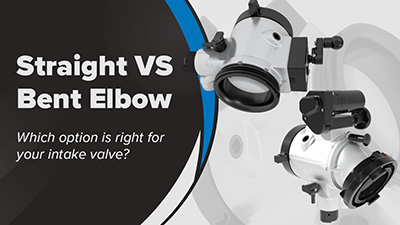When to Consider a Straight Intake Valve Vs an Elbow Intake
When you’re evaluating intake valves, you will need to decide if you want or need a straight intake valve or one with an elbow. Making this decision could depend on your department's preferences, the size of your pump panel, or the sources your department depends on for water supply.
This article dives into a few of the reasons you may want a straight intake valve and when you may benefit from the elbow. Before we dive into those, let’s look at the differences between a straight intake valve and one with an elbow.
Intake Valves: Straight vs Elbow
An intake valve allows you to control the flow of water into the pump of your apparatus. Straight intake valves and intake valves with an elbow both allow this to happen.
Straight valves come in various waterway sizes and can be ball intake valves, butterfly/wafer style intake valves, or piston intake valves. Typically, they are shorter in depth than an intake valve with an elbow.
An intake valve with an elbow works the same way as a straight intake valve with the added benefit of movement. Swiveling elbows have a joint that allows you to pivot the inlet opening if needed. This gives you the ability to connect your large diameter hose (LDH) easily rather than fighting the LDH to connect to the valve in a certain way. It will also allow the LDH lay to be positioned alongside the truck to avoid obstructing the roadway when positioning the apparatus on the scene.
Why Would I want an Elbow?
An elbow on your intake valve offers a lot of flexibility. Intake valves with an elbow include detents that allow you to rotate the elbow to a new position. This gives you the ability to direct your hose line in multiple different directions.
Here are a couple of examples of when that comes in handy:
Easy Connections
Sometimes the hydrant you need to connect to is not in an optimal location. It may be at an angle or off to one side of your intake. With an elbow on your intake, you can swivel the elbow to a different detent position to make for a more direct connection. This can minimize the likelihood of kinks and make connecting easier for your crew.
Reducing Hose Kinks
There are other times when you need to direct your hose line effectively to limit hose kinks. With an elbow, you can easily swivel to a different position that directs your hose line away from the ground or other obstacle that may cause kinking.
Why Would I Want a Straight Intake Valve?
You may want or need a straight intake valve if you have a small pump panel, are outfitting an aerial inlet, or do a lot of drafting work. For some departments, less is more, and they prefer the simple straight intake so that they do not need to adjust elbow positions.
Limited Pump Panel Space
If you’ve noticed that pump panels are getting smaller, you are not alone. Space is getting tighter and sometimes, that means your intake valve with an elbow just won’t fit. Maybe you have too many other valves nearby or the intake valve needs to fit behind a roll up door.
In these cases, a shorter straight valve without an elbow may fit better.
If your intake valve will be low to the ground on your pump panel you may also want to consider a straight intake valve. With the valve so low, an elbow could make connecting to your hose line more difficult or increase the likelihood of the hose driving into the ground and kinking, therefore reducing your flow.
Drafting
If your department drafts often, especially from a dump tank, you may want to use a straight intake valve. As you connect your hard suction hose, a straight intake is one of the easiest connections you can make. There is no need to adjust an elbow to make the connection. With a straight intake your hard suction hose will connect easily and gently slope off the truck directly into the portable tank, avoiding kinks and awkward angles.
Aerial Inlets
The preference for many departments is to use a straight intake valve on the backend of the aerial truck. A straight intake valve allows you to easily supply your aerial ladder and master stream device without worrying about adjusting the elbow on your intake valve. The shorter depth of the valve also prevents the valve from protruding further than necessary from the back of the truck.
Which Intake Valve is Right for Me?
The intake valve you choose may be based on department preference or a combination of the concerns listed above. You might have other concerns that can be addressed by a dealer or manufacturer.
If you are thorough and evaluate your options fully, you will find the right intake valve for your needs.
What else do you need to consider when choosing an intake valve? Watch our Ask TFT episode to find out!
